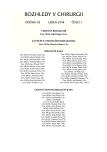-
Medical journals
- Career
Intraoperative CT-based spinal navigation: the initial 295 implants experience
Authors: P. Barsa 1; R. Fröhlich 1; F. Šebek 2; P. Suchomel 1
Authors‘ workplace: Neurochirurgické oddělení, Neurocentrum, Krajská nemocnice Liberec, a. s. primář: Prof. MUDr. P. Suchomel, Ph. D. 1; Radiologické oddělení, Krajská nemocnice Liberec, a. s., primář: MUDr. L. Endrych 2
Published in: Rozhl. Chir., 2014, roč. 93, č. 1, s. 16-20.
Category: Original articles
Overview
Introduction:
The authors describe the system of spinal navigation based on intraoperative CT imaging and the results of an initial series of patients.Material a methods:
Spinal screws inserted during 50 surgical procedures in the period between November 2012 and October 2013 were evaluated for insertion accuracy, intraoperative complications and the accessibility of the method for the selected spinal level.Results:
Out of the total of 295 screws inserted throughout all the spinal levels from C0 to S1, only 4 (1.3%) pedicle screws were found to be incorrectly inserted: a single L5 screw breached the lower cortex of the pedicle, two thoracic pedicular screws penetrated the anterior margin of the vertebral body not exceeding 3 mm of the shaft length, and a single C3 pedicle screw penetrated the upper vertebral body end-plate. None of these complications caused morbidity or required re-operation. Intraoperative CT imaging together with the navigation procedure increased the time of surgery by 30 minutes on average and patient radiation exposure during the initial and accuracy control CT scan was increased.Conclusion:
Our initial experience has shown that the CT-based computer-assisted spinal navigation system is a precise surgical modality. It enables higher accuracy in spinal screw positioning, resulting in lower surgical morbidity and increased safety for the patient. This benefit should outweigh the longer operation time as well as a higher radiation exposure of the patients.Key words:
spine surgery – operation technique – intraoperative imaging – computed tomography – navigation
Sources
1. Golfinos JG, Fitzpatrick BC, Smith LR, Spetzler RF. Clinical use of a frameless stereotactic arm: results of 325 cases. J Neurosurg 1995;83 : 197–205.
2. Willems PW, van der Sprenkel JW, Tulleken CA, Viergever MA, Taphoorn MJ. Neuronavigation and surgery of intracerebral tumours. J Neurol 2006;253 : 1123–36.
3. Nolte LP, Zamorano LJ, Jiang Z, Wang Q, Langlotz F, et al. Image-guided insertion of transpedicular screws. A laboratory set-up. Spine 1995;20 : 497–500.
4. Laine T, Lund T, Ylikoski M, Lohikoski J, Schlenzka D. Accuracy of pedicle screw insertion with and without computer assistance: a randomized controlled clinical study in 100 consecutive patients. Eur Spine J 2000;9 : 234–240.
5. Džupa V, Krbec M, Kadeřábek R, Rusnák R, Douša P, et al. Peroperační CT navigace u operací páteře a pánve: první zkušenosti. Rozhl Chir 2013;92 : 379–384.
6. Fan Chiang CY, Tsai TT, Chen LH, Lai P.L, Fu TS, et al. Computed tomography-based navigation-assisted pedicle screw insertion for thoracic and lumbar spine fractures. Chang Gung Med J 2012;35 : 332–8.
7. Amiot LP, Lang K, Putzier M, Zippel H, Labelle H. Comparative results between conventional and computer-assisted pedicle screw installation in the thoracic, lumbar and sacral spine Spine 2000;25 : 606–14.
8. Sasso RC, Garrido BJ. Computer-assisted spinal navigation versus serial radiography and operative time for posterior spinal fusion at L5-S1. J Spinal Disord Tech 2007;20 : 118–122
9. Bandela JR, Jacob RP, Arreola M, Griglock TM, Bova F, et al. Use of CT-based intraoperative spinal navigation: management of radiation exposure to operator, staff, and patients. World Neurosurg 2013;79 : 390–4.
Labels
Surgery Orthopaedics Trauma surgery
Article was published inPerspectives in Surgery

2014 Issue 1-
All articles in this issue
- Erectile dysfunction as a result of spinal trauma
- Laparoscopic cholecystectomy in children and adolescents
- Intraoperative CT-based spinal navigation: the initial 295 implants experience
-
Is thyroid and parathyroid surgery safe?
Is it suitable for one-day surgery? - Biliary stent as a cause of bowel obstruction
- Pelvic exenteration in the treatment of advanced tumours of the small pelvis
- Total pelvic exenteration – strategy of the surgery
- Urine derivation after radical cystectomy
- Perspectives in Surgery
- Journal archive
- Current issue
- Online only
- About the journal
Most read in this issue- Urine derivation after radical cystectomy
-
Is thyroid and parathyroid surgery safe?
Is it suitable for one-day surgery? - Pelvic exenteration in the treatment of advanced tumours of the small pelvis
- Biliary stent as a cause of bowel obstruction
Login#ADS_BOTTOM_SCRIPTS#Forgotten passwordEnter the email address that you registered with. We will send you instructions on how to set a new password.
- Career

